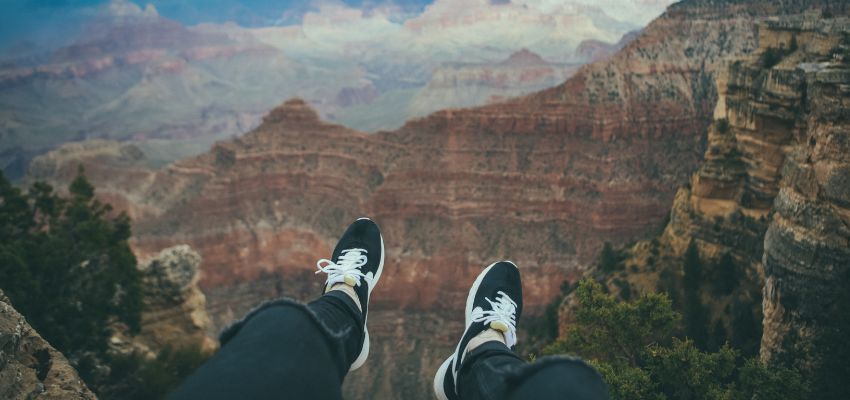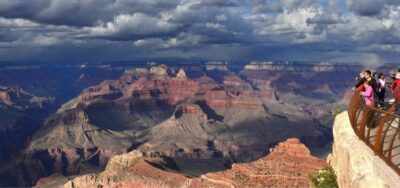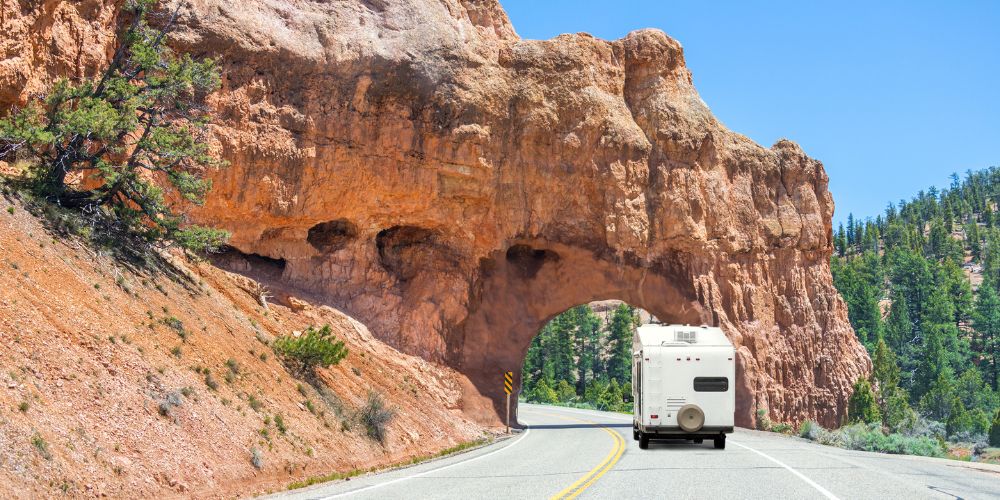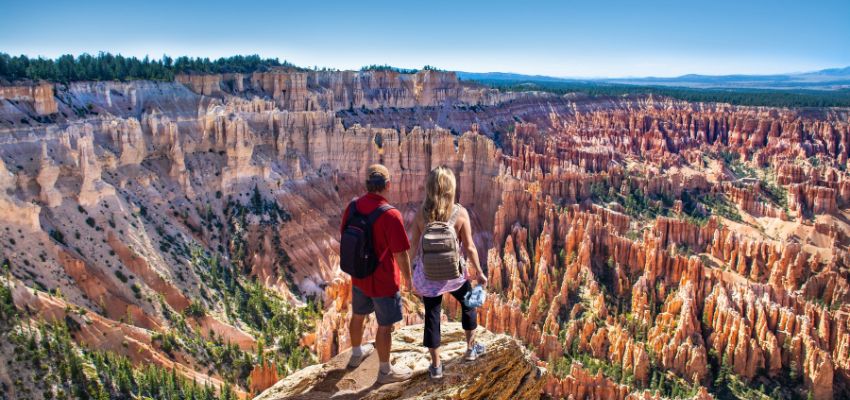The Grand Canyon may be awe inspiring, but it is important to remember that awesome things can also be dangerous. Its size, geography, and location are what make the Grand Canyon so impressive, but they are also what create some of its (thankfully avoidable) perils.
You may have seen stories in the news regarding injuries or even deaths at the Canyon due to these Grand Canyon dangers, but many of these tragedies are avoidable if you practice a bit of Grand Canyon safety.
In this post, we will explore some of the biggest Grand Canyon dangers and how you can avoid them while safely enjoying the beauty and splendor of one of the world’s greatest natural wonders.
Let’s jump in (but not literally—that is actually one of the dangers).
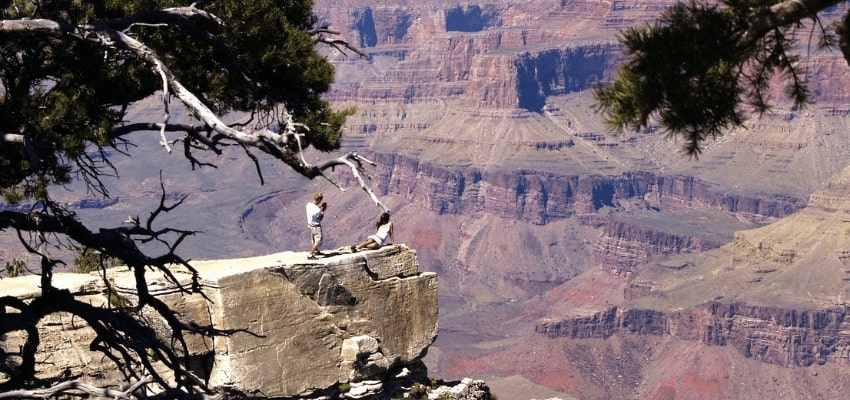
Grand Canyon Danger 1: Falling Off the Edge of the Canyon
One of the more obvious Grand Canyon dangers is the depth of the Canyon itself. Visitors often overestimate their safety as they get close to the edge of the Canyon, maybe for that perfect selfie shot, and can quickly find themselves losing their footing. Fatal falls are not the leading cause of death at the Grand Canyon, but they are one of the most preventable Grand Canyon dangers.
How to practice Grand Canyon safety
- Stay on designated trails and walkways
- Keep a safe distance of at least six feet (2 m) from the edge of the rim at all times
- Do not climb over any barriers or fences that are present in certain parts of the Canyon
- Always keep an eye on the edge of the rim and the ground where you are walking
- Do not run, jump, or engage in unsafe play or stunts near the the edge of the Canyon
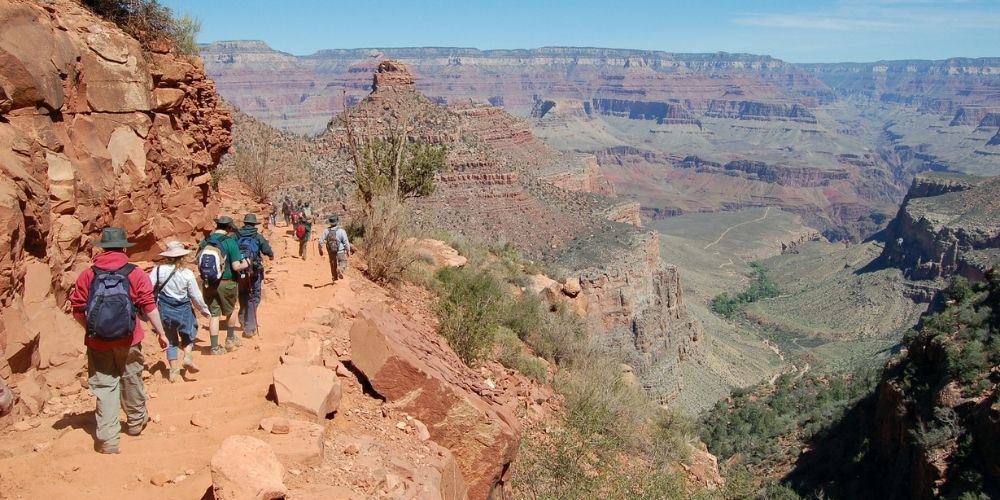
Grand Canyon Danger 2: Dehydration and Heat Exhaustion/Heat Stroke
Heat is extremely dangerous and is often underestimated by inexperienced visitors who are unused to dry desert heat, especially when hiking down into the Canyon.
It may seem counterintuitive, but the bottom of the Grand Canyon is actually hotter than temperatures above the rim—”temperature increases 5.5°F with each 1,000 feet loss in elevation” (NPS), so it is extremely important to prepare for this increase if you intend to hike below the rim.
It’s not just the heat and exertion you have to worry about when it comes to dehydration—in the spring and summer months “relative humidity often fall[s] below 10% during the day,” creating conditions that make dehydrating incredibly easy (NPS). According to the National Park Service, “rangers respond to heat exhausted hikers every day during the summer”, so make sure you come to the canyon prepared for the heat and humidity conditions.
How to practice Grand Canyon safety
- Check the weather forecast and the NPS website for alerts relating to temperatures at the canyon. If the forecast is hot, consider rescheduling activities like hiking, especially into the Canyon.
- Dress appropriately for the weather
- Avoid hiking between 10am and 4pm when the sun is high and the temperature is the hottest
- Use sunblock and reapply as indicated by the package
- Stay hydrated by drinking water or electrolyte drinks when you feel thirsty
- Eat high-energy salty foods—you lose salt as you sweat!
- Rest often in the shade
- Listen to your body and be realistic when planning your daily activities
Grand Canyon Danger 3: Flash Floods
Because the sparse, dry vegetation and soil of the Arizona desert is less capable of absorbing rainwater than other landscapes, flash floods can occur if the weather conditions are right inside the Canyon along the Colorado river.
Flash floods are uncommon, but are most likely to occur in July, August, and early September due to the increase in thunderstorms. However, they can happen any time of year if there is significant rainfall anywhere along the river. Due to the way in which water travels, a flash flood can be triggered by a thunderstorm or torrential downpour occurring in a completely different part of the canyon. The NPS notes that “[h]ikers have been killed in flash floods generated by thunderstorms as far as 25 miles away.”
Flash floods are not a risk if you are only visiting the rim of the Grand Canyon.
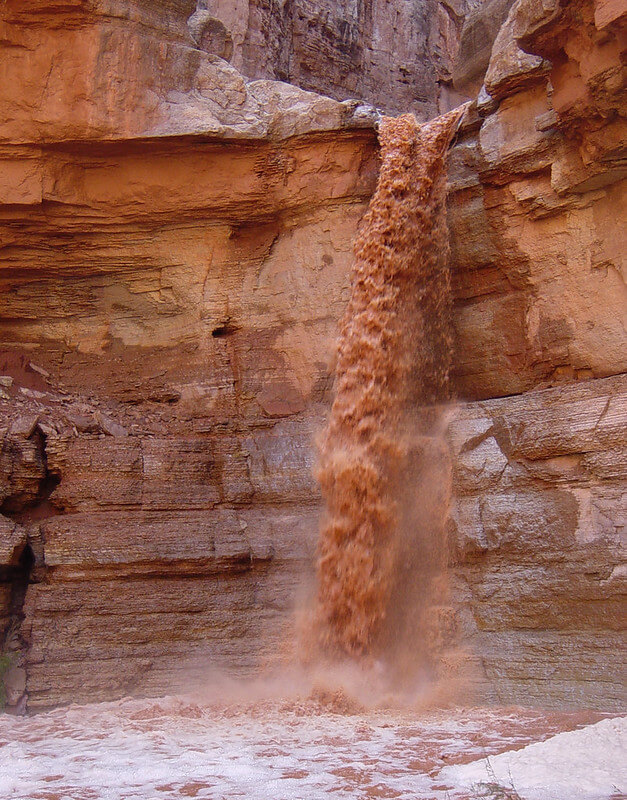
How to practice Grand Canyon safety
- Before beginning your hike, examine trail maps to identify possible escape routes
- Be especially careful hiking the slot canyons, including Grand Canyon, Marble Canyon, and Glen Canyon regions, as water can accumulate quickly in these semi-enclosed areas
- Never camp in an arroyo (A.K.A., wash, dry wash, or desert dry wash)—a watercourse that is dry most of the year but can become flooded seasonally or irregularly if there is significant rainfall or runoff
- Inspect all potential campsites along water routes for indications of past high water, such as debris lines or stains along rock walls, and set up camp higher than those lines
- Avoid areas subject to flooding
- Be especially cautious in areas posted with flash flood warning signs
- Do not cross flowing water (either streams, rivers, or flooded trails) where water is higher than your knees
- Always face upstream when near or in any creek or drainage.
- Be alert! It does not have to be raining where you are to cause a sudden flash flood in your area
- Move to higher ground immediately if you see or hear a flood coming. You can’t outrun a flood.
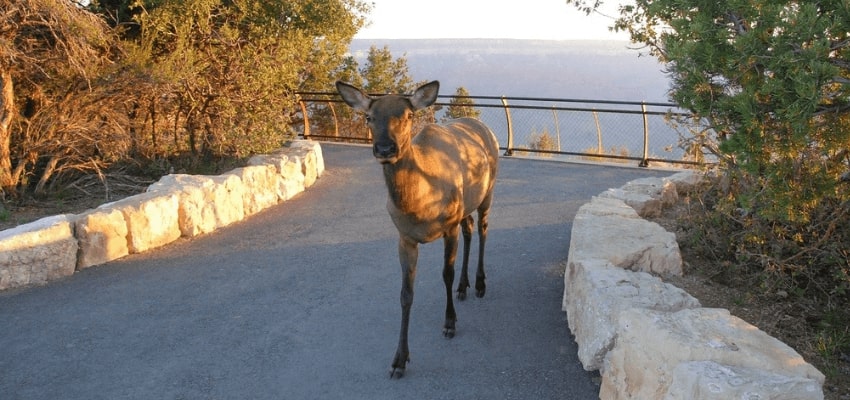
Grand Canyon Danger 4: Wildlife
Rattlesnakes, elk, squirrels—oh my! The Grand Canyon boasts a huge number of unique wildlife species for you to potentially see while you are there. It’s important to keep in mind that they are wild animals and you should not attempt to approach or feed them in any way, not only because there is a risk to your safety if you do so, but also because it is illegal to approach or feed wildlife at Grand Canyon National Park and you could be heavily fined if caught.
How to practice Grand Canyon safety
- NEVER feed wild animals, not even the squirrels—it’s both dangerous and illegal to approach or feed wildlife in Grand Canyon National Park.
- The NPS advises that you “stay at least 100 feet (30 meters) or about two bus lengths away from elk, deer, bighorn sheep, California Condors, and mountain lions” and “keep at least 50 feet (15 meters) or about one bus-length away from other smaller wildlife like squirrels, birds, and reptiles”
- If you encounter an aggressive animal (ears back, grinding teeth, rattling or shaking tail, hissing, etc), back away slowly
- If you see a baby animal, leave it alone! It has most likely not been abandoned. Most wild species leave their young alone and visit them periodically throughout the day to avoid attracting predators to their location.
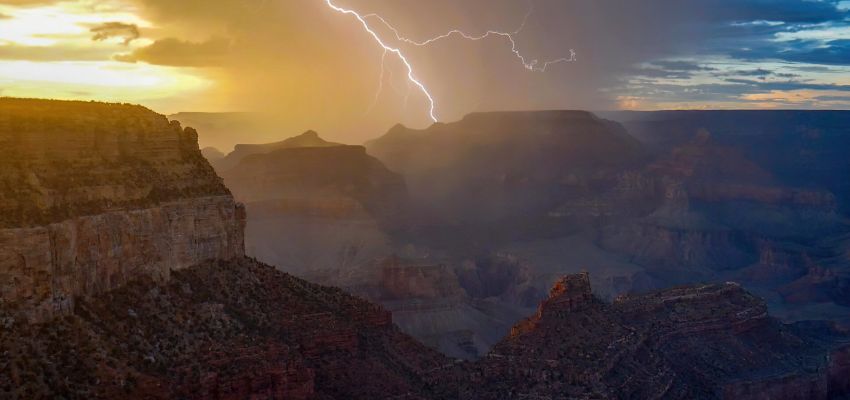
Grand Canyon Danger 5: Inclement Weather
If the desert heat wasn’t enough, the geography and climate of the Grand Canyon can also bring intense storms, lightning, tornadoes, impenetrable fog, and perhaps most surprisingly: cold! Thankfully though, most days at the Canyon are pleasant, and even the stormiest days can offer some of the most impressive views of this natural wonder.
FUN FACT: Lightning strikes an average of 25,000 times per year in Grand Canyon National Park.
How to practice Grand Canyon safety
- Check the weather forecast before you leave for the Grand Canyon and come prepared with appropriate clothing and suitable supplies
- Check the NPS website for weather alerts and travel conditions, as snow and ice can reduce visibility and create hazardous driving conditions that may result in road closures
- In the winter, dress in warm, layered clothing with a wind- and water-proof outer layer to protect against the cold, rain, wind, and snow
- In icy conditions, over-the-shoe traction devices are recommended
- Always be on alert for thunder and lightning, especially during summer months
- Take cover during thunderstorms and remain inside for 30 minutes after the storm ends
- If you are trapped outside with no safe shelter during a storm, avoid open areas and stay away from any metal or lone trees; if stuck in a wooded area, avoid the tallest trees
- While it may be tempting to get as low as possible, it is inadvisable to lay down on the ground during a lightning storm. Instead, if a lightning strike is imminent, get into a crouched position as demonstrated on the lightning danger page of the NPS website.
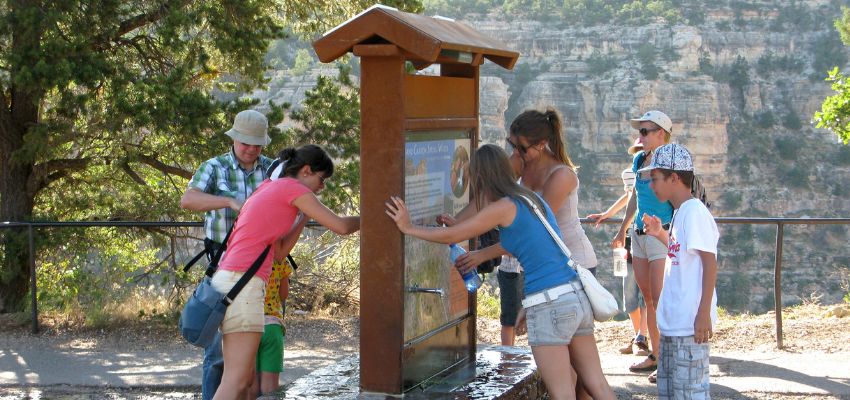
Grand Canyon Danger 6: Water Safety
Occasionally, there are problems with the water lines at the Grand Canyon. This can result in the water becoming non-potable, meaning it isn’t safe to drink, or the National Park Service enacting water conservation measures because replenishing water stores can be challenging.
During these times, accessing water can be difficult and requires some additional planning for visitors and especially hikers. If water is not available, you will have to carry in all the water you need (and possibly more than you expect—at least 1 gallon of water per day), or bring some kind of filtration/purification device in your pack.
How to practice Grand Canyon safety
- Pay attention to NPS water advisories and signage when at the park
- Fill up your water bottles only at designated filling stations
- Buy or bring bottled water—just remember to take all garbage with you when you leave
Conclusion
Yes, there are dangers at the Grand Canyon, but they can be easily managed—even entirely mitigated if you’re smart about it. There’s no reason to let safety deter you from enjoying the once-in-a-lifetime experience of seeing the beauty of the Canyon. Just be sure to take precautions like:
- Staying on the trails and staying away from the edge of the canyon
- Staying hydrated and not hiking during the hottest part of the day
- Being careful when traveling along the Colorado River
- Staying away from wildlife
- Taking weather-appropriate precautions during inclement weather
- Paying attention to water safety warnings and bringing your own potable water

